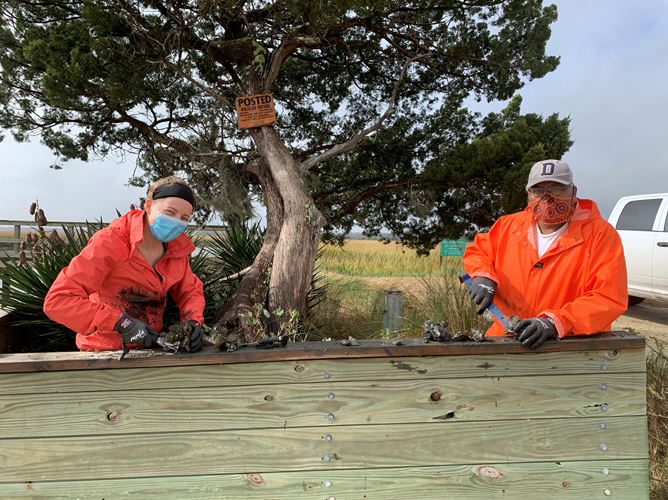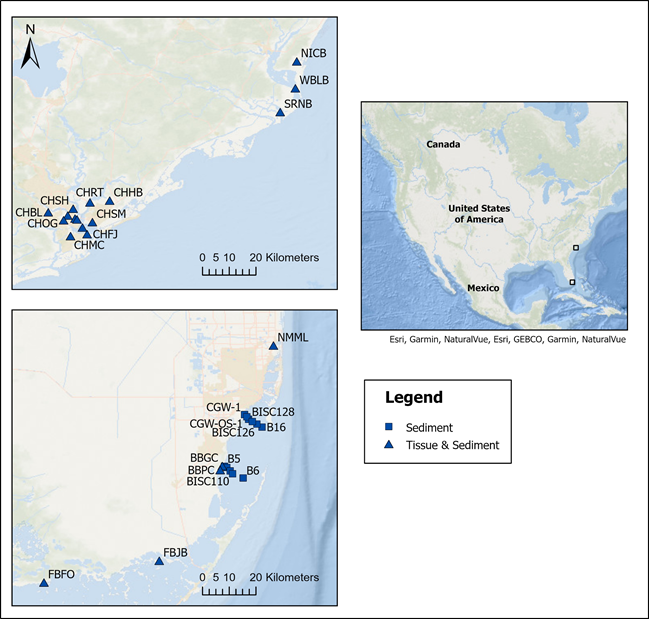
The Mussel Watch Program has monitored the nation’s coastal waters for chemical contaminants since 1986 and currently for trace metals, legacy contaminants, and contaminants of emerging concern (CECs). In 2020, the Mussel Watch Program collected Crassostrea virginica samples from a network of 31 sites on the South Atlantic coast. Results from this study will support a better understanding of the sources, fate, and transport of contaminants in the region and will fill important data gaps for local stakeholders.
Why We Care
Charleston Harbor serves as the major port for the city of Charleston, SC and is part of the Intracoastal Waterway. Charleston Harbor has undergone extensive dredging for decades so monitoring the contamination impacts of such activities is critical and makes the information from these sites invaluable to the larger Mussel Watch dataset. Additionally, the Atlantic coast of Florida includes a range of land uses including some densely populated cities, national parks and wildlife refuges, rural areas, and many barrier islands, so it is an encompassing area to monitor contamination. Thousands of chemical contaminants from many point and nonpoint sources accumulate on the South Atlantic coast every day, compromising water quality, which, in turn, threatens human and ecosystem health. Previous studies in the region have investigated legacy contaminants, such as trace elements and persistent organic pollutants (e.g., polychlorinated biphenyls (PCBs), organochlorine pesticides, chlordane, and polycyclic aromatic hydrocarbons (PAHs)). These research and monitoring efforts have helped managers limit the impact that legacy contaminants have on coastal ecosystems, but such efforts are lacking for the increasing number of new and unregulated compounds known as contaminants of emerging concern (CECs), many of which are known to be harmful to people, animals, and the environment. In response to resource managers’ concerns about the extent and impact of these chemical stressors, both continuing and new, the national Mussel Watch Program conducted a basin-wide survey to assess the magnitude and distribution of a suite of CECs, metals, and legacy contaminants on the South Atlantic coast in 2020.
What We Are Doing
The Mussel Watch Program is a national chemical contaminant monitoring program through NOAA’s National Centers for Coastal and Ocean Science (NCCOS) that was established in 1986. The national Mussel Watch Program uses an ecosystem-based approach to monitoring, which entails measuring the concentration of chemical contaminants in sediment and tissue of indigenous bivalves, such as oysters and mussels, as a way to evaluate local environmental quality. Bivalves are used as indicator organisms for chemical contaminants in their local environments because they are immobile and they bioaccumulate contaminants in the water as they filter feed up until the point at which they are reflective of the concentrations in the surrounding environment. The Mussel Watch Program currently analyzes sediment and bivalves for both legacy contaminants and contaminants of emerging concern (CECs). Legacy contaminants have been monitored within the Mussel Watch Program since 1986 and includes compounds such as chlordanes, chlorobenzenes, dichlorodiphenyltrichloroethane (DDT), dieldrins, endosulfans, hexachlorocyclohexanes (HCHs), butyltins, PAHs, and PCBs. The monitoring of CECs began in 2009 and includes contaminants such as alkylphenols, alternative flame retardants, current-use pesticides, (per- and polyfluoroalkyl substances (PFASs), polybrominated diphenyl ether (PBDEs), polybrominated biphenyls (PBBs), and pharmaceuticals and personal care products. In general, CECs are minimally regulated, not commonly monitored, but potentially toxic chemicals that are finding their way into the environment.
In 2020, the Mussel Watch Program assessed a network of 31 sites on the South Atlantic coast to be analyzed for the full suite of metals, legacy contaminants, and CECs. In this survey, 20 samples of Crassostrea virginica and 31 of sediment were collected along the South Carolina coast, with a focus in Charleston Harbor, and along the Atlantic coast of Florida following the Mussel Watch Program standard protocols. Site selection was conducted in collaboration with resources managers that are part of the Atlantic Oceanographic and Meteorological Laboratory (AOML) and it involved a strategic mixture of sites that met both programs’ monitoring needs.
The National Mussel Watch Program designed the 2020 South Atlantic coast chemical stressors survey in collaboration with NOAA Ecotoxicology Branch (Hollings Marine Laboratory) and the Atlantic Oceanographic and Meteorological Laboratory (AOML).
Benefits of Our Work
This study supplies much-needed data to the national Mussel Watch Program and to local stakeholders and managers on the South Atlantic coast and informs water quality data used by coastal resource managers to develop effective, long-term policies to protect ecosystem services provided by the South Atlantic coast.

